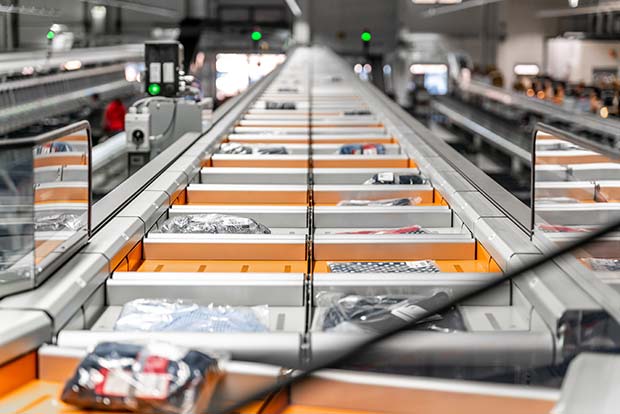Operations in distribution centres at fashion companies are usually very labour-intensive. Fashion items often have to be picked individually, which leads to long walking distances and long lead times. But DistriSort has a solution for this challenge: the Dual Split Tray Sorter. Thanks to this sorting system, the fashion company s.Oliver now processes more orders but with less manual involvement. This enables employees who were previously responsible for these tasks to benefit from further skills training in either operating the new equipment or so they can be re-deployed to other roles.
 At peak times, s.Oliver Group’s distribution centre processes at least three million articles per week. These include fashion and lifestyle items from the s.Oliver brand, as well as other brands. The items are sold in thousands of stores across Europe, including almost 800 branded stores and over 5,000 shops-in-shops.
At peak times, s.Oliver Group’s distribution centre processes at least three million articles per week. These include fashion and lifestyle items from the s.Oliver brand, as well as other brands. The items are sold in thousands of stores across Europe, including almost 800 branded stores and over 5,000 shops-in-shops.
The group’s distribution centre is in Rottendorf in the heart of Germany where the labour market is tight. Particularly at peak times, s.Oliver had increasing difficulty in recruiting sufficiently qualified workers and this meant the fashion company was forced to examine opportunities to automate its labour-intensive logistics operation.
Switching to batch picking
S.Oliver found the solution in the Dual Split Tray Sorter; An automated sorter which is designed to meet the requirements of the fashion industry. The trays are split into two parts that can be operated separately. For large items such as jeans or jackets, both parts can be used in combination, but for small items only one part is needed. As a result, the potential capacity of this sorter is around 14,400 items per hour. However, the main benefit of the Dual Split Tray Sorter in the case of s.Oliver is its ability to quickly switch to batch picking. By combining the orders from their own shops and other retailers into one large batch, the walking distances for pickers are drastically reduced. After picking, the collected items are manually placed on the sorter which then sorts the items per order. This automation enables s.Oliver to process more orders with fewer people.
Extremely compact footprint
At a logistics trade fair, s.Oliver saw the Dual Split Tray Sorter for the first time. Andreas Wetzel, Manager Logistic Operations of Freier Group Logistics which runs s.Oliver Group’s distribution centre, said: “After the fair we visited several DistriSort customers in the fashion sector which gave us full confidence in the sorter’s abilities. Also, during the selection process it became clear the sorter-system would best meet our criteria.”
One of the most important factors in choosing the right sorter was its size. The available space was only 52 x 24 meters. But DistriSort’s equipment would occupy just 45 x 11 meters which was still sufficient to have no less than 278 exits. The solution was mounting cross diverts underneath the sorter so the moment a tray opens, one of the cross diverts can send the sorted item either left or right, doubling the number of exits that would have been possible without them.
Implementation on schedule
The sorter has been seamlessly integrated into s.Oliver’s logistics process. A significant example of this is the way in which the sorted items are processed. Under each exit there is a plastic tote with a unique ID which is linked to the ID of the relevant exit by barcode scanning. When a tote is filled, it is disconnected from the outlet by an operator and moved to the packing stations via conveyors. Thanks to this working method, SAP’s warehouse management system knows exactly which items from which order are in which tote.
s.Oliver are completely satisfied with the whole project as the implementation went smoothly and according to plan:
“DistriSort responded positively to all our suggestions. In addition, I would like to emphasise that I have never seen such a tidy and well-organised construction site”, said Andreas Wetzel.
Payback within three years
Thanks to the speed and efficiency of the sorter, double shift working is no longer necessary. An additional advantage is the dispatch process which is now virtually error-free and has led to a major reduction in the costs of dealing with the return of unwanted items. As a result, s.Oliver’s return on investment for the system will take less than three years.
Andreas Wetzel concluded: “The sorter certainly meets all our requirements and is five days a week in use.”




Comments are closed.